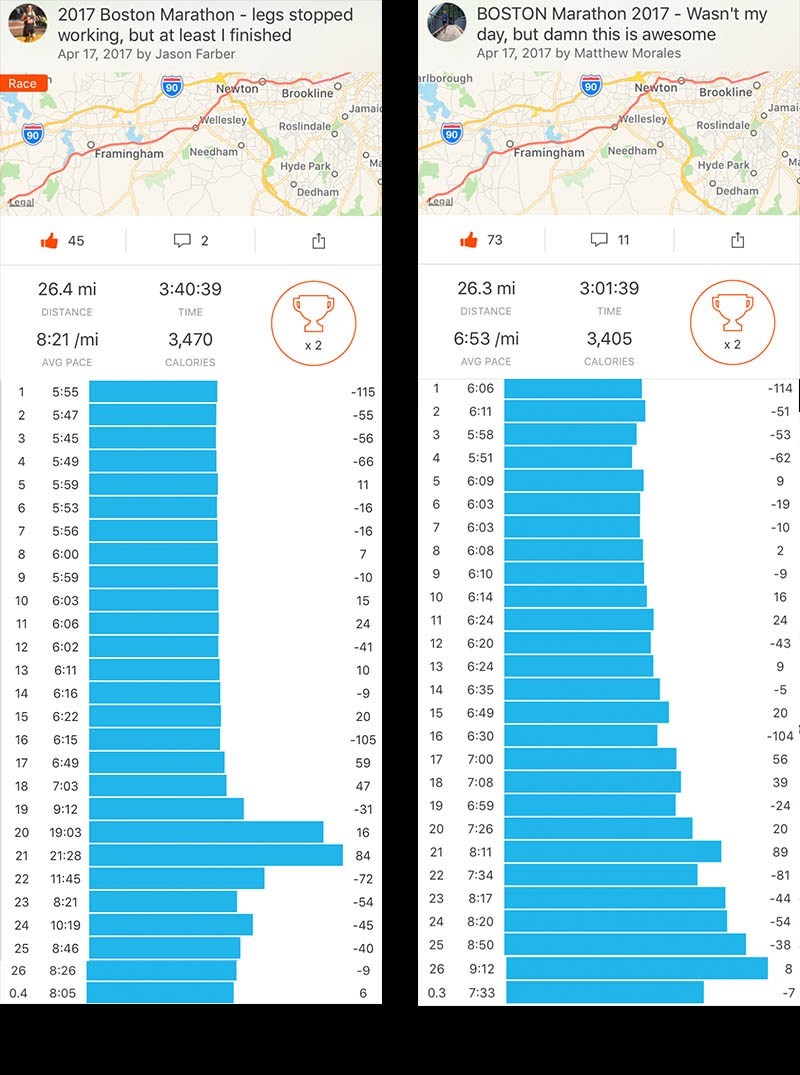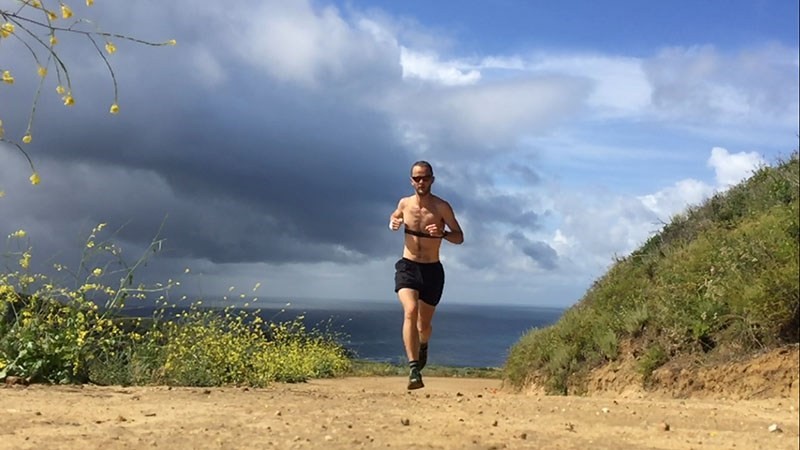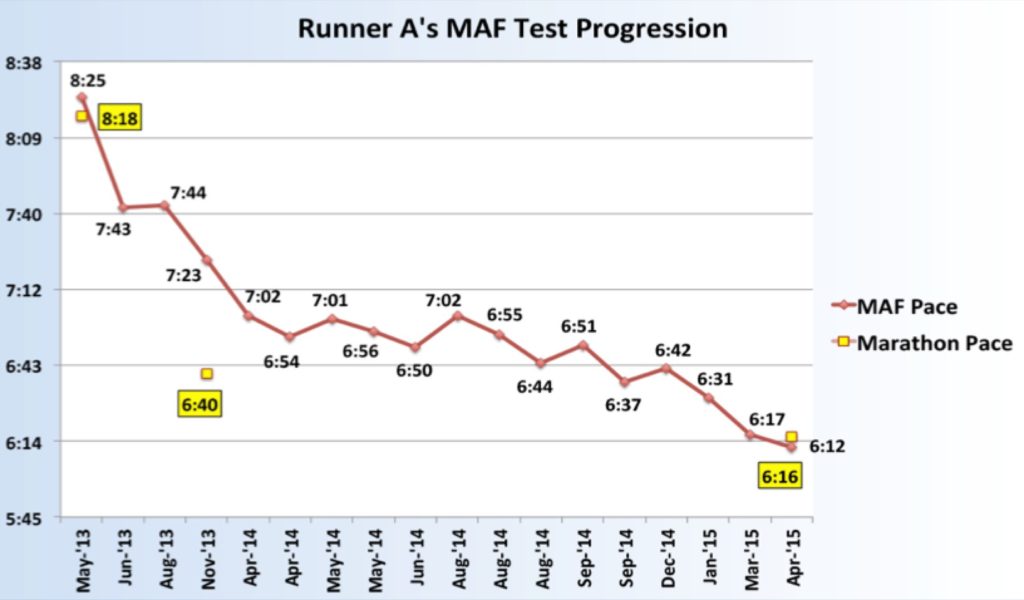Today sharing the amazing and joyful story of internet friend Floris Gierman who took his marathon time from over 4 hours to 2:44 by embracing the slow 🙂
Just this weekend Floris (age 34) ran the Tunnel Vision marathon in 2:55 at a Heart Rate ave 157 (see his results here)
Floris is an endurance athlete and self-experimenter living in Irvine, California. He is fascinated to discover ways to improve human performance, in particular in running. He writes about it on his site Extramilest (http://extramilest.com/blog/)
……….
Low Heart Rate Training, Turning Frustrations Into Excitement
Low Heart Rate (HR) Training has been one of the key elements that improved my marathon time from 4 hours 11 minutes to 2 hours 44 minutes at the Boston marathon. Coaches like Dr. Phil Maffetone, Mark Allen and Dr Mark Cucuzzella educate athletes to train mostly at a low heart rate, eat the right nutrition and live a balanced lifestyle with enough rest and recovery. Many endurance athletes have had great success with low heart rate training. Unfortunately, there is a large group of athletes who fail to enjoy the many long-term benefits because they get frustrated to train initially at a slower pace, feeling judged by friends and strangers, embarrassed to post their runs on apps like Strava, etc. In this article, we’re diving into ways to overcome frustrations with low HR training. This can help turn frustrations into excitement and long term health benefits.
Slowing down your training pace
Dr. Phil Maffetone developed the 180-formula to calculate your ideal HR zone to train at, which is related to your age and other health factors. Another way to find your HR zone is by taking a Lactate Threshold (LT) test or Fatmax-test at a medical lab. Training at a low HR means that most athletes have to slow down significantly in training for the first few weeks or months. For example, an athlete is used to training at 9 minutes per mile (5:35 min /km) and the HR for this athlete at this pace is 160 beats per minute. With a MAF 180-formula, this athlete might have to train at a HR of 145 beats per minute, resulting in a much slower pace of possibly 11 or 12 minutes per mile.
The goal is to teach your body to become more efficient in utilizing stored body fat for energy instead of sugars. This fat adaption is very beneficial for athletes, especially in the later stages of endurance races such as a marathon, ultra marathon or triathlon. Athletes with poor fat burning abilities often get in trouble by running out of energy and in many cases hit the wall. Running at a low HR in training helps improve your fat burning abilities. During a race this helps limit your risk of dropping out of a race. Other benefits of low HR training are less stress on your body, a reduced risk of injury, and having more energy after your training.
Frustrations in Low Heart Rate Training
A common response I continuously hear from runners is: “It is very frustrating to run so slow, I am almost standing still, am I doing this right, how can I possibly improve like this?”
I have connected with thousands of runners over the years and almost all of them mentioned they have to slow down significantly (several minutes per mile or km) with MAF training compared to their usual training pace. Many athletes have to take walk breaks to stay aerobic, especially if there are any hills, wind or higher temperatures.
There is a light at the end of the tunnel with the right mindset, patience and determination. Low HR training has a fast growing following of dedicated fans. There are many benefits, such as improved race times, higher energy levels during and after a work out, faster recovery times, less stress on your body, and much lower chance of injuries. I’ve been training at low HR for more than 4 years now. Initially I also struggled to slow down in training; however, I found ways to turn my frustrations into excitement. Many athletes fail to stick to low heart rate MAF training, so this post will discuss why athletes fail and what can be done to improve your chances of success to become a faster, healthier, happier athlete.
In this post we’re going to discuss:
- the logic behind slowing down in your training and benefits for race day
- what you can expect from low heart rate MAF training over the months and years
- turning frustrations with MAF training into excitement
Let’s dive right in!
The Mechanics behind Low Heart Rate Training
Heart rate is the number of heartbeats, usually expressed as beats per minute (BPM). The heart beats to supply oxygenated clean blood from the left ventricle to the blood vessels of the body via the aorta. The heart rate is a reflection of your body’s oxygen need. Your brain can force your heart to change your heart rate based on your body’s needs. This HR can be very low, 30 to 40 bpm in rest for those with a great aerobic function to as high as 200 in young athletes in all-out efforts.
Your body uses two main sources for energy: glucose and body fat. Most athletes, even very skinny ones, have a massive supply of calories available from body fat, while glucose storage in your body is limited. Many marathon runners have experienced hitting the wall, also called bonking. This is caused by the body’s inability to burn enough fat for energy. If you must rely mostly on sugar, you have limited energy available. Once glycogen stores have been used, your blood sugar drops depriving your muscles and brain of fuel.
Here are a two examples of runners who found themselves in trouble at the 2017 Boston Marathon around the 20 mile / 32km point, because they ran out of energy from glucose and were not able to get enough energy out of body fat. The 2017 Boston marathon was a hot race year, resulting in elevated heart rates, with increased chances of bonking.

If you develop your fat burning aerobic system, your body is able to use a lot of energy from stored body fat. This can be accomplished through diet and nutrition, stress management and training at the appropriate heart rate intensity.
The training approach that I recommend is highly influenced by elements from Dr. Phil Maffetone and his Maximum Aerobic Function (MAF) training approach. I strongly believe all endurance athletes should start training with a GPS running watch with heart rate monitor. The 180 Formula created by Dr. Maffetone calculates your ideal individual aerobic training Heart Rates.
This MAF training zone is your optimal training intensity that burns mostly fat for fuel. Training at this MAF HR frequently develops your aerobic system, it improves your fat burning abilities so it teaches your body to use more energy from body fat and you improve your endurance performance.
Heart Rate Monitors are a great biofeedback device that help limit your body’s wear, tear and chances of injuries. A heart rate monitor takes the guesswork out of training and can help increase your aerobic speed significantly. Over time it can help make you a much faster endurance athlete!
You might be a fast runner, however the reason you have to slow down significantly in your low heart rate training runs is that you’re aerobically not fit. For example 6 time World Champion Ironman Mark Allen, trained most of his run at 5 min mile pace, however when he started training at MAF, even he had to slow down in training by 3 1/2 minutes to 8:30 min / mile at first. Some runners are in shape to run a 3 hour 30 minutes marathon or faster, yet aerobically they need to slow down to 11:00 or 13:00 min / mile to run aerobic in training. If you recognize yourself in this situation, realize that is totally normal and nothing to worry about.
What to Expect From MAF Training over Time
When you use the 180 Formula, you’ll come up with a number that is your MAF HR. You’ll improve your fat burning abilities by training at or within 10 beats under this number. The closer to your MAF number, the faster your aerobic development. Here are a few things you might experience in the first few weeks or months of low heart rate training:
- Within minutes of starting your run, your heart rate might shoot up and you’ll have to slow down significantly or take walk breaks
- you don’t understand why you’ll have to run this slow
- you might get passed left and right by slow runners, you used to always run faster than them
- your friends might wonder what’s going on with you running so slow
- you might feel embarrassed to share any of your runs on social platforms because its so slow
- you start to wonder if you calculated the 180 formula right (most probably you did! If you’re ever in doubt between 2 numbers, always pick the lowest one)
- you wonder if you have an exceptionally low or high HR and this 180 formula doesn’t work for you (the 180 formula is a great starting point for almost all runners wanting to improve their aerobic system).
- you will finish your first few runs at very slow pace and don’t feel tired at all, you feel you could have continued running much longer. Am I doing this right?
When your lizard brain start feeding you doubtful thoughts, remember:
- You’re not alone, almost everyone struggles starting out with the 180 formula in the first few months.
- Realize that you will not be walking / running slow forever
- Patience is absolutely key. Most people want to see results right away. Have a beginner’s mind and think about your long term advantages of having a well developed aerobic base.
Aerobic progress can happen fast. If you run a MAF test, your monthly aerobic progress might look like this:
Prior to MAF training
Mile 1 = 11:30 min / mile (7:09 / km)
Mile 2 = 11:45 min / mile (7:18 / km)
Mile 3 = 12:05 min / mile (7:30 / km)
Mile 4 = 12:15 min / mile (7:36 / km)
Mile 5 = 12:25 min / mile 7:42 / km)
Total time = 60:00 minutes
Average = 12:00 min / miles (7:27 / km)
After 1 month of MAF Training
Mile 1 = 11:00 min / mile (6:50 / km)
Mile 2 = 11:15 min / mile (6:59 / km)
Mile 3 = 11:35 min / mile (7:11 / km)
Mile 4 = 11:50 min / mile (7:21 / km)
Mile 5 = 12:05 min / mile (7:30 / km)
Total time = 57:45 minutes
Average = 11:33 min / mile (7:10 / km)
After 2 month of MAF Training
Mile 1 = 10:40 min / mile (6:38 / km)
Mile 2 = 11:00 min / mile (6:50 / km)
Mile 3 = 11:10 min / mile (6:56 / km)
Mile 4 = 11:30 min / mile (7:09 / km)
Mile 5 = 11:50 min / mile (7:21 / km)
Total time = 56:10 minutes
Average = 11:14 min / mile (6:59 / km)
Let’s look at the progress of this specific athlete. After 1 month of MAF training, at the same HR this athlete ran 2 minutes and 15 seconds faster. After 2 months of MAF training, almost 4 minutes faster at the same HR.
If you translate this to a marathon, at the same HR, per mile 46 seconds faster at same HR x 26.2 miles, this could mean almost 21 minutes faster at the same effort. The progress in the first several months is typically larger, after a while, the monthly progress becomes smaller.
Here is an example chart of my own MAF Pace Progression over an 18 month period.
If you are not progressing
Naturally, healthy athletes should improve aerobically over time. If you’re training the right way with a lot heart rate following Dr. Maffetone’s 180 formula, and you’re not progressing or even regressing in your training, several factors could be blocking your progress. Analyze how you feel, any recent colds or illnesses, higher than normal stress levels at work or in your personal life, unhealthy nutrition, lack of rest, recovery and sleep, under-training or over-training, too much cross training or high HR training, miscalculation of your MAF pace, etc. All these factors can influence your fat burning abilities and slow down your aerobic development. If this is the case and you have seen very limited to no progress when starting out with MAF training, focus to improve these factors in your life first.
Change Your Mindset, Turn Frustrations into Excitement
Let’s face it, many athletes have a very hard time slowing down their pace significantly to a mellow jog or walk to keep their heart rate at or below MAF. Not only do they feel embarrassed to be slower than any other runner out and getting passed left and right by friends and strangers. Several athletes mentioned they stopped posting their runs on apps like Strava or Nike plus, because they feel judged about their slow pace by others. The biggest enemy for most athletes starting out with low heart rate training is their own ego. Take on a beginners mind, realize you have to invest time and energy to create a solid foundation. Patience and consistency in training is absolutely key to make low heart rate training work.
Ryan Holiday wrote one of my all time favorite books, entitled The Obstacle is the Way. He goes in much detail about overcoming obstacles in three critical steps:
- Our attitude or approach is very important how we look at our specific problems
- The energy and creativity with which we actively break down obstacles and turn them in opportunities.
- Our inner will that allows us to handle defeat and difficulty. When being faced with an obstacle such as running at a much slower pace that you’re used to, we must try to be objective. To keep our emotions under control and see the good in a situation. To ignore what disturbs or limits others. To believe this is an investment in time and effort worth making, because you’ll build a foundation that will benefit you for years to come as a faster, stronger, healthier athlete. To focus on what can be controlled. Epictetus wrote: “Persist in your efforts. Resist giving in to distraction, discouragement, or disorder”.
Over the years I’ve studied a lot of highly successful athletes, entrepreneurs, artists and ruckus makers. Two characteristics of these top performers are persistence and determination. So when you feel discouraged and unmotivated to train, ask yourself the questions:
How bad do you want It?
In the book A Complaint Free World by Will Bowen, the author explains how your thoughts create your life and your words indicate what you’re thinking. Your word choice can make a huge difference in your thought process, for example instead of using the word ‘problem’, consider ‘opportunity’, instead of ‘struggle’, consider ‘journey’, instead of ‘enemy’, consider ‘friend’.
Maya Angelou famously quoted: “If you don’t like something, change it. If you can’t change it, change your attitude. Don’t complain”.
With this article I’m giving you permission to slow down, to run and be able to have a comfortable conversation. To finish a run and feel that you have a lot of energy left in your tank. No pain no gain makes zero sense and will get you injured and burned out in the long term. Once you start seeing aerobic improvements after several weeks or months, this is very motivating to see your efforts are working. It’s a cycle that keeps repeating itself. After a few months you should improve your fat burning abilities, run faster and feel great.
A Few Other Strategies for Success
Slowing down your pace might feel pretty boring, especially when first starting out with MAF training. There are a few other ways to keep your runs fun and exciting:
Downhill Sprints – slowly jog or walk up a mountain, hill, or bridge, then run down at a faster but aerobic pace until your HR alarm goes off at your MAF pace. My ideal grade for faster downhill aerobic sprints are 200 to 400 feet drop per mile (38 to 76 meters per km).
Short Sprints – after a good warm up, run several short 8-10 second sprints. You will run a fast interval, however because it’s very short, your heart rate will stay mostly aerobic. Make sure your HR comes down for a few minutes before your next short sprint.
Cross Training – you can improve your fat burning abilities by cross training in many different ways, like aerobic bike rides, swims, hikes in the mountains, elliptical, etc. In the base building phase, I have had most success with running as many aerobic miles as my family / work / life schedule can handle. Cross training can be helpful; however, I focus mostly on running more miles to improve.
Make it a game – this idea came from Mike Capka in our Extramilest Facebook Group: I played games early on: 1) How far can I go without setting the HR alarm 2) What is the fewest number of alarms I can have during a run 3) How high can I go up the hill before my alarm goes off without slowing to a walk? #3 is really fun and rewarding once you can make it up the hill without slowing to a walk. It also gets to be very encouraging.
Success Stories
Don’t just take my word for it. Here are a few quotes of runners from around the world to shared their experiences with low HR training:
James J: The low HR training was the key for my London Marathon this year 2:58:34, knocking nearly 1/2 hour off my PB. I followed a 4 month plan with mid-week and weekend long runs done just under my aerobic heart rate. (Which was very slow to begin with) No one really believed I could do it except me – I just trusted in the training and paced for a 2:58. The advice really works! Next race: The Boston Marathon!
Joe R: I’ve only done about 4 months of MAF, lost 6% body fat, 4 kilos and bid my best time @ Berlin (3:14:08), Boston qualified… best of all I feel great!! Kudos for MAF.. Next goal under 3 @ Boston!
John K: I just ran the Phoenix marathon in Feb ’17 and was shocked to come in at 3:08 with none of the cramping that plagued me at the end of New York (3:25). At my current age, that time will definitely get me into Boston in 2018! So excited, for anyone else considering Maffetone/HR training, I strongly encourage trying it. Takes some getting used to if you have a “no-pain no-gain” mentality, but the results make it worth it.
Matt: After running a 3:08 marathon, I trained hard with the goal of running a 3:03 BQ time, however, I bonked and ran a 3:10 marathon. Then I developed a low HR training plan and purchased a HR monitor to do all my runs under 150 bpm. This regimen worked for me too! Last Sunday, I ran a 2:59 marathon, and I met all of my most aspirational goals for this race: BQ, sub 3 hour, negative split.
Many more great success stories on Phil Maffetone’s website: https://philmaffetone.com/success
Closing Thoughts
Slowing down your training pace by several minutes per mile or km can be frustrating at first. Patience is absolutely key and a significant number of runners fail to stick to low HR training, because they are not willing to invest the time and effort it takes to break through. By changing your mindset about running slow, you can change frustrations into excitement.
Once you start seeing small initial improvements, this will fuel your fire that you’re on the right track. It’s an amazing feeling to finish a run without feeling exhausted, and realize you could keep going much longer. Over time you can become a much faster, healthier and happier runner! Have fun!





So when do you start running fast? Only during a race?
I’m questioning about people who are on keto and fat adapted and their MAF. Because, if we considering the metabolic profile of keto’s runner’s are quite different than “normal” runner.I mean MAF is obviously around 80% of VO2max. So is the formula of the MAF for keto?
Arnaud great question . not easy answer each is unique but going keto does not usually allow one to run far above MAF.